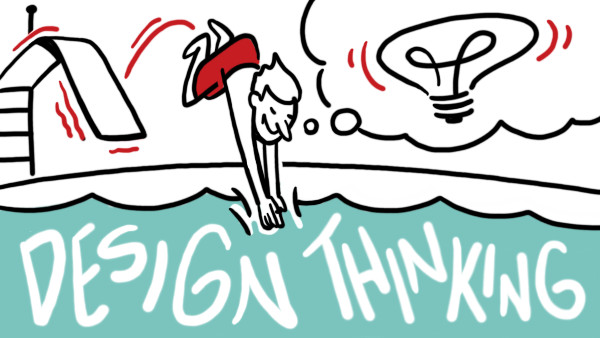20 Reliable Websites, Books, Courses, and Podcasts for Design Thinking Beginners and Beyond
Have you already read our post on Design Thinking 101? If not, check it out.
Whether you’re exploring basic Design Thinking principles, or you’re ready for a deep dive on integrating it into your organization, chances are you want to learn more. And if you want to learn more, you’re probably wondering where to start.
Have no fear – we’ve compiled our favorite design thinking resources for any level. And we even categorized them to cover all of your bases. Read on to learn all about creative ways to work and experiment with Design Thinking, featuring practices and methodology to fit any industry from HR to Instructional Design and everywhere in between!
The Tool Kit: Stanford’s d.school and/or IDEO
Both Stanford’s d.school and IDEOU are groundbreaking resources perfect for tackling the nuts and bolts of design thinking. Whether you’re just starting out, or looking for some direction, you’ll find a wealth of knowledge and experiential learning at either site focused around a solidly human-centered point of view.
If you’re craving collaboration with design thinkers worldwide, or even a certificate proving your prowess, you’ll probably want to veer towards IDEOU. To simply get your creative juices flowing in a design-thinking direction, and to get as hands-on as you want (or don’t want) the Stanford d.school is likely more your style.
Check out a TED Talk from the IDEO’s founder:
And here’s an interview chock full of real-world applications to help you get your mind percolating on ways design thinking can work for you:
Ready to Implement: The Design Sprint Kit
Confident that it’s time to bring your design thinking expertise into your organization? Maybe you’re all set to dip a toe in and apply it to an actual issue?
The Design Sprint Kit developed by a team at Google is an excellent and adaptable open-source set of methods. It provides a framework to build upon as you form a team, shape a vision, and start problem-solving. Adopting this approach can save your team between 4-6 weeks per issue once you become accustomed to the kit. Since it’s open-source, the developers who created the kit welcome contributions to improve it over time.
Resources for Facilitation: A veritable library of techniques
Once you’ve embarked on your design thinking journey, ensure you maximize your efforts by picking the appropriate approach for working with your specific audience or collaborators. That’s where this cornucopia of facilitation methods compiled by Session Lab comes into play. Filter by one or more of seven pertinent categories.
For example, if you’re starting with a new team, choose from over 150 activities to boost teamwork and build teams. You’ll also find tons of icebreakers and exercises designed to energize. If your focus is on brainstorming and innovation, you’ll want to pick from their vast selection of idea generation methods. For obstacles that might arise along the way, there are methods for issue resolution and analysis.
After finalizing a deliverable or solving a problem, wander over to categories that offer methods you can use to facilitate goal setting, leadership development, and decision-making.
Tangible takeaways: 2 Printable References
Everyone loves a good takeaway. We found two printable books that make an excellent reference during the design thinking process, a great reminder of what was learned after the fact, and even a convenient receptacle for note-taking.
HubSpot’s Design Thinking: The Book is a comprehensive overview of all things design thinking. It is 85 pages packed with everything you need to know to implement design thinking. It covers immersion in the process for developing a prototype, and each crucial step in between. As a bonus, you get tips on how design thinking can improve business outcomes, and activities to try with your team.
The Design Thinking Field Guide from IBM is more compact, clocking in at 52 pages, but equally valuable. In this book, you’ll find information that’s laid out elegantly and easily understood. They’ve separated the field guide into two sections. “Learning It” summarizes fundamental concepts behind design thinking as it’s understood by IBM, while “Leading It” is a handy reference for facilitating what you’ve learned in small teams of your own.
Design Thinking in Action: 4 Case Studies
If you’re intrigued by the concept of design thinking but unsure how it fits in with your needs, check out these case studies.
- Here’s one detailing how a nonprofit in San Francisco’s Bay Area was able to apply design thinking to an issue limiting their capabilities to service the parents of special-needs children.
- Read this case study from IBM to implement design thinking in a large organization.
- We’ve all heard of Airbnb, but you may not be aware of how design thinking factored into the company’s massive success. In fact, design thinking just might be the secret ingredient that prevented Airbnb from being a cautionary tale instead of the success story it’s become.
- Finally, if you’re wondering how design thinking gets done without actual designers, these case studies are for you!
Ongoing Education: 11 Books, Courses, Blogs and Videos on Design Thinking
There are countless additional resources you can tap into as you swim through the deep end of design thinking. Here are a few of our favorites!
Books:
- Scramble: How Agile Strategy Can Build Epic Brands in Record Time, by Marty Neumeier
- The Design of Business: Why Design Thinking is the Next Competitive Advantage, by Roger L. Martin
- The Design Thinking Playbook: Mindful Digital Transformation of Teams, Products, Services, Businesses and Ecosystems, by Michael Lewrick
Courses:
- MIT’s Mastering Design Thinking
- Coursera Design Thinking Classes
- Columbia University Design Thinking Courses

